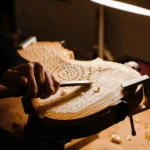Violin Fittings Set: When should you replace them?
Back to BlogAll musicians want to improve their performance at some point, and if you have been in the music world for a little longer, you know that accessories have a very important role in this. It’s normal for musicians to change them once and a while, but is there a right time? When should you replace the violin fittings set? How does it work?
The accessories for violins were invented to help musicians improve their musical instrument performances. The violin fittings set allows players to learn new skills while improving old techniques during practice. When using accessories on a violin, it’s important for every violinist to know how these products should be used. Otherwise, you may end up producing sounds that are different from what you intended.
A violin came with a fitting set. When should you change it?
And this leads to our topic, but first, you need to understand the accessories so you know exactly how you want to improve your violin.
You know it is time to upgrade your violin fitting set when you feel like your instrument needs a new sound.
Setting up a string instrument is a crucial step in your violin-playing experience; it includes: carving the bridge, the chinrest, tailpiece, pegs and nut, the fingerboard, and setting the strings.
A specific set of accessories will give your instrument a whole new personality, and each fitting’s material has its role.
The violin fittings set & accessories that have a great impact on your violin
The bridge and the soundpost are very important, you don’t need to change them frequently, but a few adjustments with your luthier will make your violin sound new/different! The violin bridge and soundpost are parts of your violin that significantly affect the overall sound it produces. If you want to get the best sound out of it, you need to keep these in good shape.
The Tailpiece
The tailpiece on a violin is another thing that can improve the quality of the sound produced. It can also be adjusted to fix any errors in the sound or vibrations. By adjusting the tailpiece, you can play the right notes to create perfect harmony for your tune.
When choosing a new one, you will find a wide range of options and one of them with its own particularities. As an example:
- Ebony tailpieces bring a brighter timbre
- A boxwood one brings a round and sweet timbre.
An important reminder: regardless of the tailpiece of your choice, you must keep in mind that the tailpiece should have a suitable size that allows you to adjust to the after length of your violin correctly, that could be of 1/5 or 1/6 of the string length.
The Tailgut, Fine Tuner and Strings
The tailgut is also an important choice here: a nylon tailgut makes the sound more round, sweet, and free. The Kevlar brings a direct and sharp sound. The tailgut is most commonly sold in thicknesses ranging from 1.90mm to 2.20mm on violins and violas. In contrast, cellos use it around 3.00mm. The thickness will depend on what you want from it. A thicker gut will be more stable, but it won’t allow as much vibration in the tailpiece.
The choice of a violin fine tuner can affect the pitch of a violin. A fine tuner should be small enough not to cause discomfort when used. It should not be too long, and its start should coincide with the tailpiece’s nut so that it does not change the tuning of the E string after length.
Violin strings can have many characteristics and the material also influence them. Having the right set can make a massive difference, as you can get different brightness, tonal quality, and tension. On our blog, we talked about when it’s the time to change the strings and we give you our best tips on how to choose them! You can check it out here.









